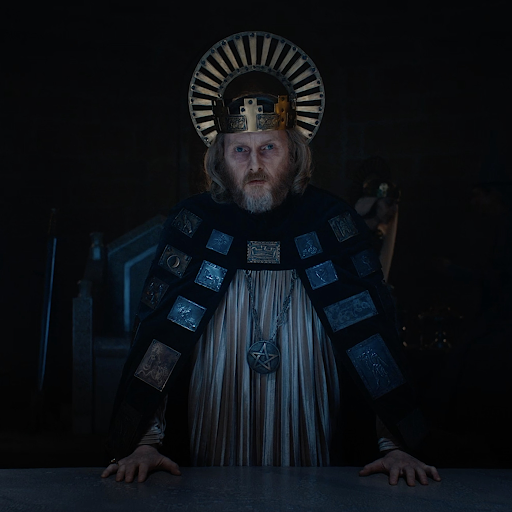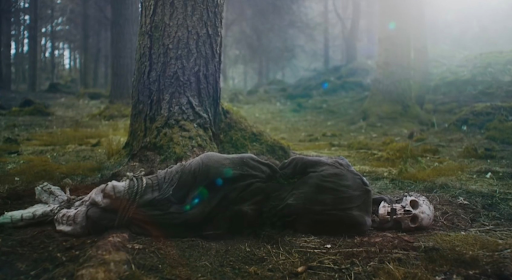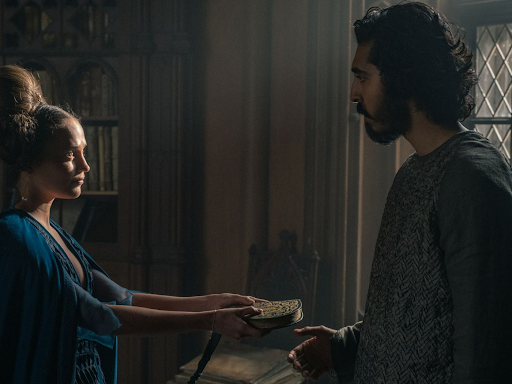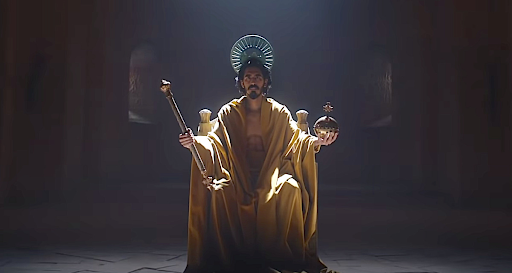These films’ failures to win the approval of devotees indicates that despite being thousands of years old, ancient works are not exempt from the confines of the source. This is what makes David Lowery’s screenplay for The Green Knight (2021) so daring. His film is not just a recreation of the Arthurian original but a response as well. Despite many major deviations from the events of the source material, the film is true to the heart of the myth and embodies a similar tone despite its occasional alternate events.
In the film’s most famous scene, the Green Knight enters the room, and makes his fateful proposition. Gawain’s acceptance is not bold, it is scared and reluctant. As he takes to his knees the Knight raises his axe in offering. Gawain refuses, instead using Excalibur to deliver the deadly blow. In the text Gawain sees an enemy kneeling in submission as much less of a threat. He confidently raises the axe and mightily strikes downward.
Gawain grips to his ax and gathers it aloft--
The left foot on the floor before him he set--
Brought it down deftly upon the bare neck,
That the shock of the sharp blow shivered the bones
And cut the flesh cleanly and clove it twain,
That the blade of bright steel bit into the ground (421-426).
Curiously, the story that the people of Gawain’s village seem to latch onto in the film with their stories and puppet shows is much more akin to the myth, in which Gawain’s smiting of the Green Knight is an act of bravery, not of fear.
A year later, when Gawain embarks on his journey he is almost immediately set upon by teenaged bandits. Instead of fending them off, they subdue Gawain, taking everything from him and leaving him tied up to die. Lowery uses a clever time lapse here showing the seasons passing as Gawain slowly starves to death on the forest floor, unable to escape his bonds. Suddenly he awakes from his morbid dream, but the message of what could have happened is clear. The quest nearly ended before it even began.
The second major change that Lowery makes is to Gawain’s moral character. The mythical Gawain, though powerful, is known for his rectitude. Lowery robs him of that too. We first find Gawain in a brothel. We learn that he frequents it and is particularly close with a woman named Essel. Despite their relationship Gawain refuses to make any commitment to her. Then there is his on-screen motivation: which is solely for himself. Arthur asks him prior to the Green Knight’s entrance to tell him a story, and Gawain responds that he has none. His willingness to take the Knight's challenge can be seen as a response to the desire to finally have a story of his own to tell. Standing in contrast is Gawain’s speech in the text in which he begs Arthur to let him take on the challenge. “My body, but for your blood, is barren of worth; / And for that this folly befits not a king, / And it is I that have asked it, it ought to be mine,” (357-358). Here, his sole motivation is for King Arthur’s honor, and this is shown by the way Gawain demeans himself in the process of asking.
After Gawain beheads the Green Knight, and becomes a celebrity, he uses his new fame in the worst ways. He carouses about in bars, trying to drink away the threat looming in the future. At another part of the film Gawain is faced with the opportunity to help a ghostly damsel in distress. He asks her what she will do for him if he completes this task for her. Her response is likely the same as the audience’s “Why would you ask me that?”. Gawain does eventually oblige but such a question is one that would likely not even enter his mind in the poem.
A central attribute to Sir Gawain and the Green Knight is the way our hero is tested along his journey. The Gawain Poet pits him against two tests. The most obvious is the beheading test: how will he answer the challenge to take a knee before the Green Knight and meet his axe? The second is what is colloquially known in Gawain scholarship as “the love test”.
David Lowery’s changes to this portion of the story are perhaps the most jarring, probably because one could easily say that Gawain decisively fails the love test. He allows much more than a kiss, but an act of sexuality that concludes with the lady exclaiming “you’re no knight!”. Gawain does not make good on his agreement however, instead he leaves the castle in a hurry and runs into the lord on his way out, at which point the lord takes his kisses, indicating that he knows more than he is letting on.
Also worth mentioning is that Gawain’s encounter with the spirit of Saint Winifred practically constitutes a third test. Winifred is a woman who was brutally raped and murdered by a nobleman, who beheaded her and threw her head into the spring. When she meets Gawain, she asks him if he will retrieve her head from the spring. He does, and this bodes well for the quality of Gawain’s character. Here Lowery gives Gawain an opportunity to offer dignity to a woman who has been starkly wronged by a powerful man.
Finally, Lowery changes how Gawain reacts to the most important test - facing his death at the hand of the Knight. Like in the text, Gawain kneels down, and flinches at the first blow. In the text, Gawain braces himself for a second blow, and the Knight swings, but does not complete the strike, simply saying that he was seeing how Gawain would react. In the film however we receive an extended alternate ending sequence a la La La Land (2016), in which Gawain runs away from the second blow. He leaves the Green Chapel, mounts his horse and rides back to Camelot, where he is received as a hero. He inherits Arthur’s throne and becomes a powerful ruler. As the years progress we see evidence of his conquest. Finally, invaders come to Camelot, breaking down the castle door. Gawain removes the magic girdle from his waist, and his head dramatically falls from its shoulders.
Lowery’s motives are ambiguous. One could assert that he is simply varying the story of Sir Gawain for the sake of telling something new. Although he does accomplish this, Lowery’s revisions to the story are part of the conversation he is having with it. Sir Gawain and the Green Knight became the classic poem it did because it addressed something that was of serious concern to people in that society. Gawain’s fealty to the code of chivalry, and steadfastness in doing right save his life in the end.
Lowery gives us a modern myth in which we don’t know what Gawain’s fate is. Whether he lives or dies is left up to the imagination. Throughout this film Gawain fails time after time to do the right thing, and at the end as he looks death in the face, he does what is honorable. He may still die; we don’t know. Lowery wants us to know that doing the right thing won’t save us, but right or wrong death will come for us. He invites us to consider what kind of death we want to have.
Image Credits:
Wonderland Magazine
Vox
Geek Girl Authority





 RSS Feed
RSS Feed
